The Latest Report
|
|
PDF Version is available: Click here |
The first task of the committee was to carry out a thorough survey of how bridges suffered from the tsunami using Internet-based satellite photos. We checked more than three thousand bridges in the Tohoku and Kanto areas, finding that more than two hundred had been washed away (Figure 1). Following a field survey, the exact number of bridges washed away was determined to be 222, including 28 railway bridges and 40 relatively large road bridges (Table 1). To further the evaluation of tsunami force on bridges, it is necessary to know the dimensions of both damaged and undamaged bridges. A database of these bridges has been constructed, based on drawings obtained from the administering authorities in charge of maintenance, and analysis of the data, both practical and theoretical, is now under way.

Figure 1 Location of bridges swept away by the tsunami
Table 1 Number of bridges swept away
|
Figure 2 shows bridges, both those swept away and nearby ones that survived, by bridge type and length. Few nearby bridges survived in the case of steel girder bridges and long bridges.
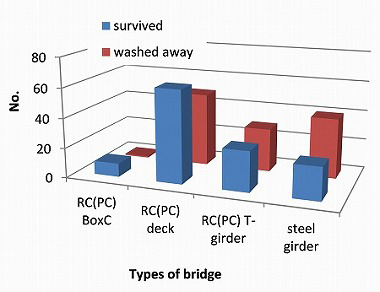
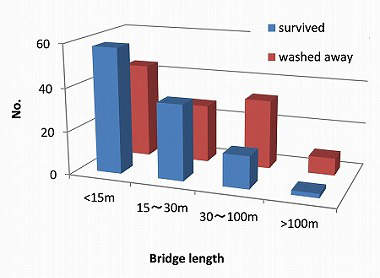
Figure 2 Category of bridge (road bridge)
Comment: railway bridges are not included in Figure 2
Professor Kenji Kosa, et al. proposed an index, β, for evaluating the resistance of bridge girders to the influence of a tsunami (equation (1)). β is the ratio of the resistance derived from the weight of the bridge to the horizontal force exerted by the tsunami.
 (1)
(1)
where, ρw is the unit density of water (1030 kg/m3), v is the velocity of the tsunami current (assumed as 6 m/s), A is the projected area (m2), μ is the friction coefficient (0.6), W is the weight of the girder, Cd is the coefficient of drag by equation (2), respectively.
 (2)
(2)
where, B is the width of the bridge and D is its depth.

Figure 3 Index β for RC and PC bridges

Figure 4 Index β for steel girder bridges
Figure 3 and 4 show the value of index β for the bridges surveyed. It is difficult to draw a clear conclusion from these figures. One reason for this is probably the constant horizontal velocity assumed for the tsunami; although it is taken to be 6 m/s, in reality it must have been different in each area.
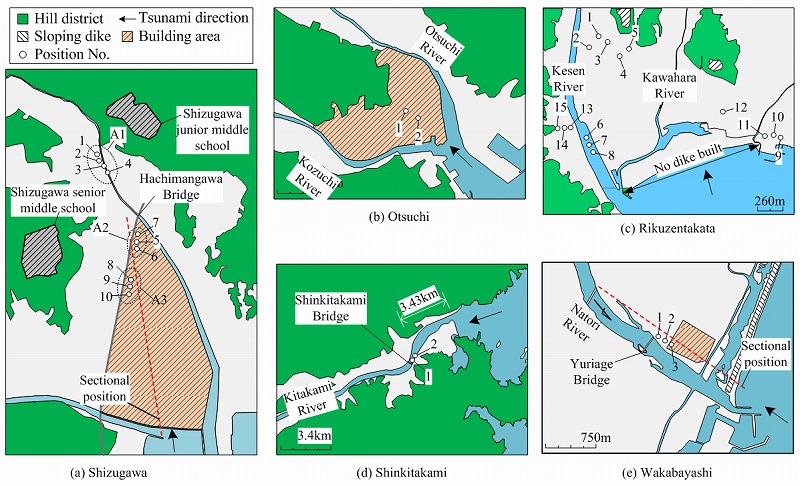
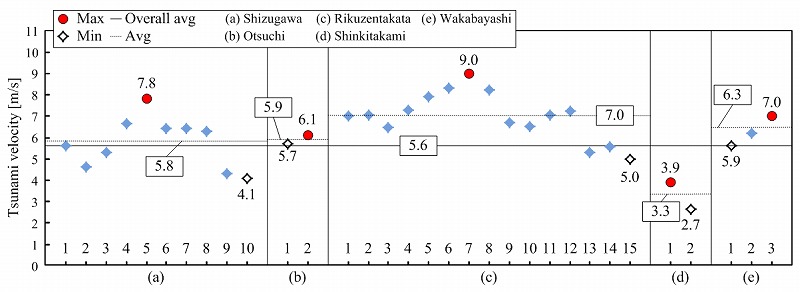
Figure 5 Velocity of tsunami observed in each area
Figure 5 shows tsunami velocity as obtained by Prof. Kosa's analysis of videos. It is clear that there is a significant variation in tsunami velocity by location.
Figure 6 shows β values for six bridges in the Shizugawa area (area (a) in Figure 5). A ranking of "A" in Figure 6 means that the bridge was completely washed away. A ranking of "C" means a bridge with almost no damage. It is clear from this figure that the average β value for washed-away bridges is lower than 1. This is much lower than the average β for bridges without damage. This indicates that β can be used as a simple and useful index to evaluate the resistance of bridges to the effects of tsunami.
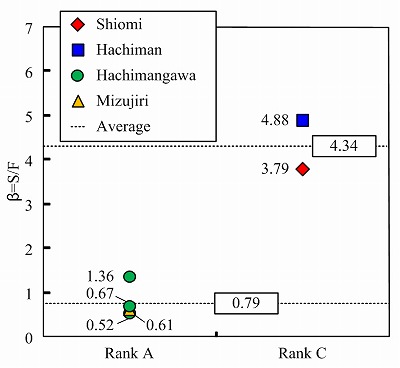
Figure 6 Values of β in the Shizugawa area
As explained, the β value is an index of the resistance of a bridge girder to horizontal force. However, observed damage to bridge stoppers and anchors, as exemplified in Figure 7, shows that many bridge girders must have undergone rotation in the process of being washed from their piers. Therefore, a further index, MR/MA, is introduced as equation (3). The mechanism of rotation damage is illustrated in Figure 8.
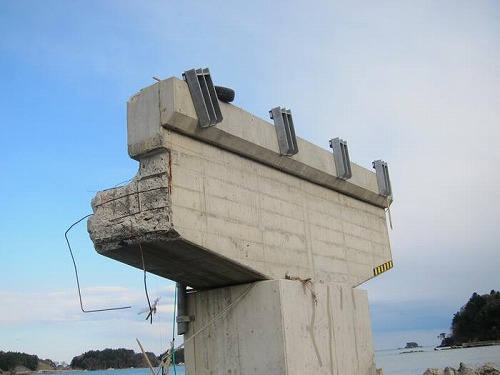
Figure 7 Stoppers on the Utasu-Ohashi bridge
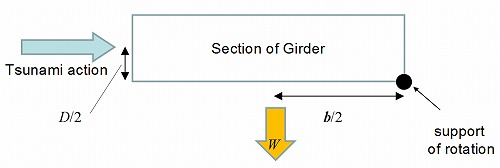
Figure 8 Mechanism of damage by rotation
 (3)
(3)
where,
MR: resisting moment
MA: acting moment
b: width of girder
D: projected height of girder
W: weight of girder per unit length
Values of MR/MA are calculated for 47 bridges on the Sendai plain and plotted in Figure 9 along with their β values. The average β of surviving bridges is 2.7 times that of washed-away bridges. The average MR/MA of surviving bridges is 4.1 times that of washed-away bridges.
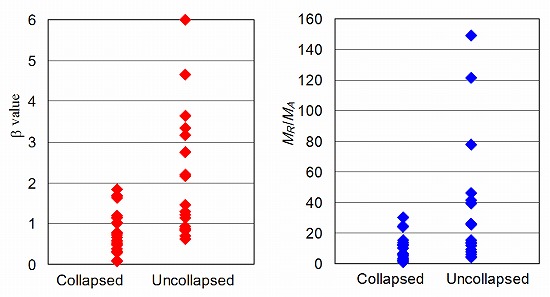
Figure 9 β and MR/MA for 47 bridges on the Sendai plain
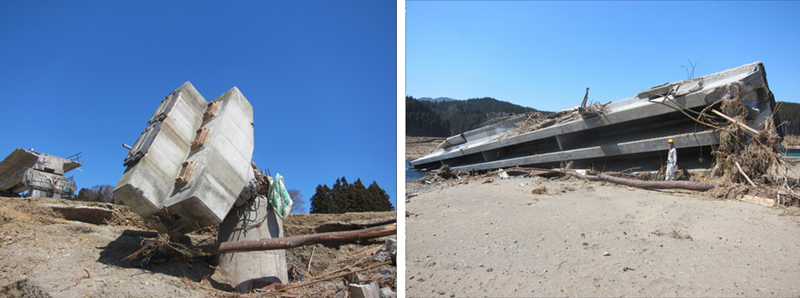
Figure 10 Overturned PC girder and damaged piers of railway bridge
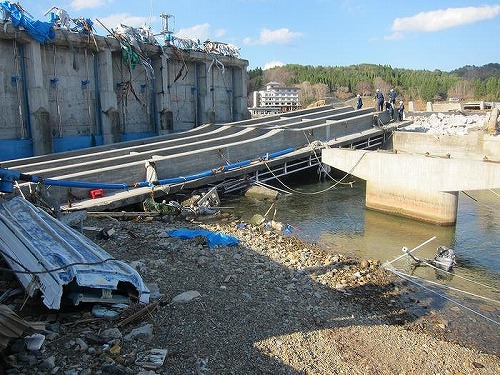
Figure 11 Overturned girder in the case of a low bridge near a sluice gate (Minato-hashi)
Figure 10 shows an example of very severe damage in the case of a railway bridge. The PC girders were completely washed away and the piers were also severely damaged. The resistance of a bridge to this kind of damage may be evaluated using either β or MR/MA. The committee is continuing to discuss damage mechanisms and methods of evaluating resistance in such cases.
In some cases, bridges appear to have been damaged by lift force, as in Figure 11 for example. Here, a large lift force might have arisen due to the presence nearby of a sluice gate structure. This disaster is characterized by the many kinds of damage it caused.
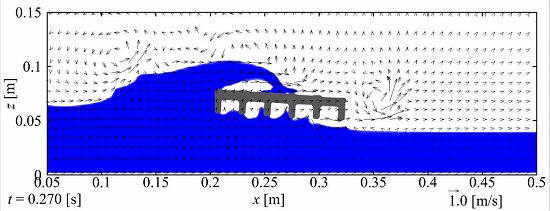
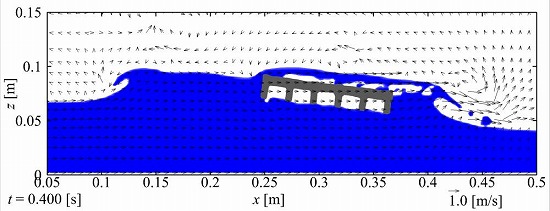
Figure 12 Simulation of bridge deck behavior under tsunami action
The behavior of a bridge deck can be discussed in relation to the horizontal and vertical components of tsunami force acting on it. The committee is currently carrying out numerical simulations and will also implement experiments to gain a full understand of how tsunami forces act. One example of a numerical simulation by Prof. Mizutani et al. is shown in Figure 12. With help of such numerical simulations, we expect to propose a rational approach to the design of bridges and the analysis of existing bridges against tsunami.
The committee's findings to date will be reported at a JSCE workshop on June 26, 2012.